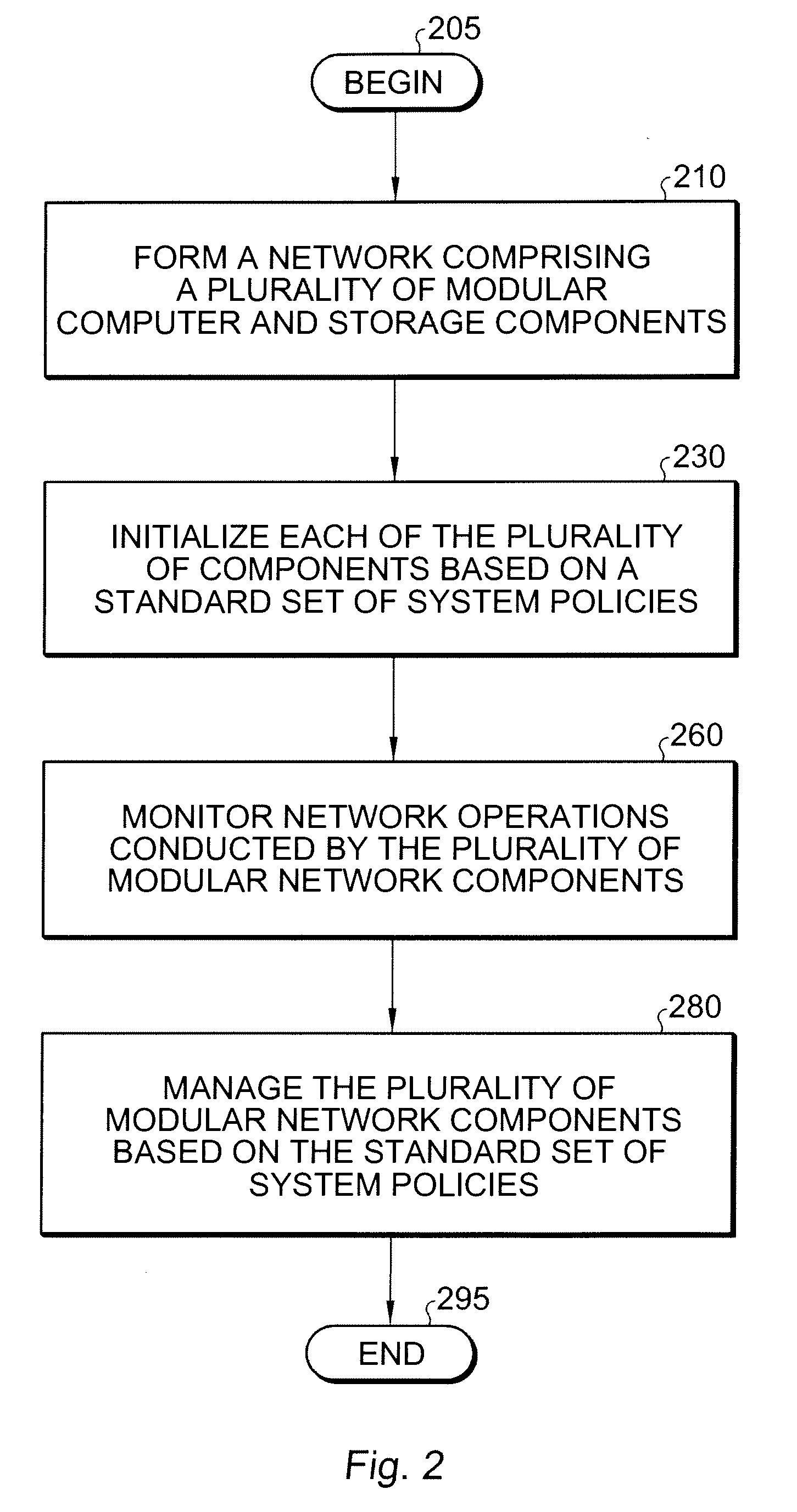[0018]FIG. 1 is a high level
block diagram of a computing system 100 comprising a plurality of managed modular components 110, 120. In this embodiment of the present invention, a plurality of compute modules 120 and storage modules 110 are coupled together via a network infrastructure 130 to form a computing system 100. A compute module 120, as will be understood by one skilled in the relevant art, is a computer,
server or the like whose primary functionality is
processing of data. Similarly, a storage module 110 is a modular component whose primary function is one of storage of data. To some degree a compute module 120 will possess some ability to store data and a storage module 110 will have some ability to process data; however, the functionality and design of each is such that its primary role, be it storage or computing, is driven by its inherent capabilities. For example, a compute module 120 may possess a number of processors including field programmable gate arrays. Conversely, a storage module 110 may include one of many forms of storage media including hard disk, tape, flash, etc. While each module possesses an interface to the system 100, the actual capabilities of each module can vary. Indeed one
advantage of the present invention is to optimize performance of the system by capitalizing on the differing capabilities of each of the plurality of modular components 110, 120.
[0019]Turning again to FIG. 1, the system 100 also includes an initialization module 150, a monitor module 160, and a management module 170. Each of these modules is coupled so that they may interact with one another as well as with the remaining modular components 110, 120 of the system 100. In addition to these modules, a storage medium 175 is coupled to the management module 170, according to one embodiment of the present invention, to provide to the management module 170 a plurality of system policies.
[0020]The policies maintained within the storage medium 175 and utilized by the management module 170 identify guidelines from which the management module 170 can implement modifications to the system 100. In addition, policies can include performance utilization parameters and / or indices that the management module can use to determine whether one or more components should be added or removed from the system or whether application tasks should be reallocated.
[0021]The storage medium 175 can, according to another embodiment of the present invention, include initialization protocols that can be transferred to the initialization module 150. When a new module is added to the system 100 or when an existing module has been removed and then at a later time is returned to an operational state, the initialization module 150, using protocols gained from the storage medium 175, automatically initializes the component and brings its capabilities online to the system 100. Similarly, when the management module 170 determines that a component's resources are no longer benefiting the system 100 and determines the system 100 would be better off without the component's contribution, the initialization module 150 can initialize procedures to remove the component from the system and place it into a dormant state.
[0022]According to one embodiment of the present invention, policies, protocols, procedures, indices and the like are predetermined and presented to the management module 150 for automatic implementation. In another embodiment of the present invention, policies stored in the storage medium 175 can be modified to reflect a changing environment.
[0023]As previously discussed and shown in FIG. 1, the monitor module 160 is coupled to the management module 170 and the system 100. The monitor module gathers information from each of the plurality of modular components 110, 120 throughout the system 100. Information including utilization of component resources, application tasks assigned to each of the components, and other performance indices is gathered by the monitor module 160 and conveyed to the management module 170. In one embodiment of the present invention, information gathered by the monitor module 160 is analyzed to determine whether the information complies with existing policies. When a component fails to meet an established policy or performance parameter, the identity of the component and the details of the policy breach are conveyed to the management module 170 for action. In other embodiments, the monitor module 160 conveys information to the management module 170 on a real time basis.
 Login to View More
Login to View More  Login to View More
Login to View More 


